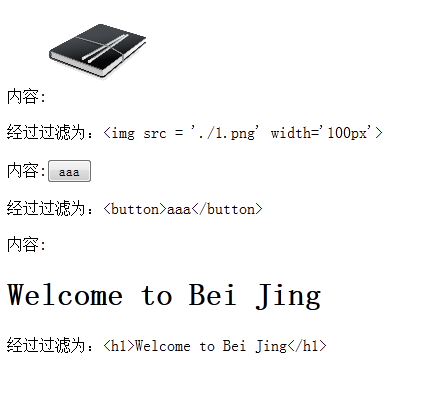Zend Framework过滤器Zend_Filter用法详解
本文实例讲述了Zend Framework过滤器Zend_Filter用法。分享给大家供大家参考,具体如下:
引言:过滤器是对输入内容进行过滤,清除其中不符合过滤规则的内容,并将其余内容返回的过程。
Zend中有个Zend_Filter组件用来实现过滤的功能。其中有个Zend_Filter_Interface子类,该子类为实现一般过滤器提供了接口。
要实现过滤器类,需要实现该接口中一个名为filter()的方法。
下面通过实例来演示如何使用Zend_Filter中定义的过滤器,该例演示如何实现字母转小写的功能。
代码:
<?php require_once 'Zend/Filter/StringToLower.php'; //加载子类 $filter = new Zend_Filter_StringToLower; //实例化对象 $temp1 = "ABCDefGH"; //定义待过滤内容 $temp2 = "我爱Nan Jing"; echo "内容:".$temp1."<p>经过滤后为:"; echo $filter->filter($temp1); echo "<p>"; echo "内容:".$temp2."<p>经过滤后为:"; echo $filter->filter($temp2);
结果:
内容:ABCDefGH
经过滤后为:abcdefgh
内容:我爱Nan Jing
经过滤后为:我爱nan jing
为什么如此神奇呢?不禁让我想探索一下其内部的构造!下面来研读一下其内部的工作原理。
class Zend_Filter_StringToLower implements Zend_Filter_Interface
{
/**
* Encoding for the input string
*
* @var string
*/
protected $_encoding = null;
/**
* Constructor
*
* @param string|array|Zend_Config $options OPTIONAL
*/
public function __construct($options = null)
{
if ($options instanceof Zend_Config) {
$options = $options->toArray();
} else if (!is_array($options)) {
$options = func_get_args();
$temp = array();
if (!empty($options)) {
$temp['encoding'] = array_shift($options);
}
$options = $temp;
}
if (!array_key_exists('encoding', $options) && function_exists('mb_internal_encoding')) {
$options['encoding'] = mb_internal_encoding();
}
if (array_key_exists('encoding', $options)) {
$this->setEncoding($options['encoding']);
}
}
/**
* Returns the set encoding
*
* @return string
*/
public function getEncoding()
{
return $this->_encoding;
}
/**
* Set the input encoding for the given string
*
* @param string $encoding
* @return Zend_Filter_StringToLower Provides a fluent interface
* @throws Zend_Filter_Exception
*/
public function setEncoding($encoding = null)
{
if ($encoding !== null) {
if (!function_exists('mb_strtolower')) {
require_once 'Zend/Filter/Exception.php';
throw new Zend_Filter_Exception('mbstring is required for this feature');
}
$encoding = (string) $encoding;
if (!in_array(strtolower($encoding), array_map('strtolower', mb_list_encodings()))) {
require_once 'Zend/Filter/Exception.php';
throw new Zend_Filter_Exception("The given encoding '$encoding' is not supported by mbstring");
}
}
$this->_encoding = $encoding;
return $this;
}
/**
* Defined by Zend_Filter_Interface
*
* Returns the string $value, converting characters to lowercase as necessary
*
* @param string $value
* @return string
*/
public function filter($value)
{
if ($this->_encoding !== null) {
return mb_strtolower((string) $value, $this->_encoding);
}
return strtolower((string) $value);
}
}
研读:
源代码意思大概是先实现Zend_Filter_Interface接口。
定义一个私有变量$_encoding,初始值为null,一般私有变量都是以_下划线开头。
然后通过构造函数进行初始化工作,设置encoding。
至于这个encoing属性是作何用的,我就不大清楚了,反正为了它,源码写了不少代码。
类中有三个方法,一个是setEncoding,一个是getEncoding,一个主要功能的filter。有两个方法都是为了encoding来写的。
在构造函数中使用setEncoding方法直接用$this->setEncoding()就可。就可以把私有属性设置好值了。
然后根据私有属性的内容来选择使用什么方法来使得字母变小写。
我去,这个类考虑的东西还真够多的。其实核心代码就那两句,strtolower((string) $value)。
这个类很酷,我从来没用过私有属性。考虑问题也没有作者那么全面,各种验证,各种情况考虑。比如,
从构造函数中就可以看出他考虑问题的全面性。
if ($options instanceof Zend_Config) {
$options = $options->toArray();
} else if (!is_array($options)) {
$options = func_get_args();
$temp = array();
if (!empty($options)) {
$temp['encoding'] = array_shift($options);
}
$options = $temp;
}
if (!array_key_exists('encoding', $options) && function_exists('mb_internal_encoding')) {
$options['encoding'] = mb_internal_encoding();
}
if (array_key_exists('encoding', $options)) {
$this->setEncoding($options['encoding']);
}
总的来说还是值得佩服的。
下面谈谈过滤器链,它的作用是将多个过滤器串联起来配合使用。过滤器链就是多个过滤器的一个连接。在对指定的内容进行过滤时,
每个过滤器将按照其顺序分别进行过滤或者转化操作。当所有的过滤操作都执行完毕时,过滤器链返回最终的过滤结果。
听起来蛮有趣的啊!
具体实现步骤是什么呢?
首先要为类Zend_Filter实例化一个对象,然后通过该实例的addFilter()方法向过滤器链中添加过滤器。
下面通过示例演示如何使用过滤器链对数据进行多重过滤及转化。
代码:
<?php
require_once 'Zend/Filter.php'; //加载Zend_Filter类
require_once 'Zend/Filter/Alpha.php'; //加载Zend_Filter_Alpha子类
require_once 'Zend/Filter/StringToUpper.php'; //加载Zend_Filter_StringToUpper子类
$filterChain = new Zend_Filter(); //创建过滤器链
$filterChain ->addFilter(new Zend_Filter_Alpha(" "))
->addFilter(new Zend_Filter_StringToUpper());//向过滤器链中添加过滤器
$temp1 = "12345asdf67asdfasdf";
$temp2 = "#$%^!@fffff";
$temp3 = "Welcome to Bei Jing";
echo "内容:".$temp1."<p>经过过滤后为:";
echo $filterChain->filter($temp1);
echo "<p>";
echo "内容:".$temp2."<p>经过过滤后为:";
echo $filterChain->filter($temp2);
echo "<p>";
echo "内容:".$temp3."<p>经过过滤后为:";
echo $filterChain->filter($temp3);
echo "<p>";
结果:
内容:12345asdf67asdfasdf
经过过滤后为:ASDFASDFASDF
内容:#$%^!@fffff
经过过滤后为:FFFFF
内容:Welcome to Bei Jing
经过过滤后为:WELCOME TO BEI JING
分析:
这里的Alpha很强大啊,过滤数字和特殊字符,连空格都能过滤。还好我初始化的时候加了个参数" ",才使得空格保留了下来。
为何如此神奇呢?
核心代码就这一块
public function filter($value)
{
$whiteSpace = $this->allowWhiteSpace ? '\s' : '';
if (!self::$_unicodeEnabled) {
// POSIX named classes are not supported, use alternative a-zA-Z match
$pattern = '/[^a-zA-Z' . $whiteSpace . ']/';
} else if (self::$_meansEnglishAlphabet) {
//The Alphabet means english alphabet.
$pattern = '/[^a-zA-Z' . $whiteSpace . ']/u';
} else {
//The Alphabet means each language's alphabet.
$pattern = '/[^\p{L}' . $whiteSpace . ']/u';
}
return preg_replace($pattern, '', (string) $value);
}
分析:这里对内容进行过滤,如果不是字母或者空格,就统统去掉。用到的php方法是preg_replace。此外,还用到了正则表达式。[^a-zA-Z]表示除此之外的其他字符。
这里的$whiteSpace成员属性,是初始化的时候设置的,具体代码如下:
public function __construct($allowWhiteSpace = false)
{
if ($allowWhiteSpace instanceof Zend_Config) {
$allowWhiteSpace = $allowWhiteSpace->toArray();
} else if (is_array($allowWhiteSpace)) {
if (array_key_exists('allowwhitespace', $allowWhiteSpace)) {
$allowWhiteSpace = $allowWhiteSpace['allowwhitespace'];
} else {
$allowWhiteSpace = false;
}
}
$this->allowWhiteSpace = (boolean) $allowWhiteSpace;
if (null === self::$_unicodeEnabled) {
self::$_unicodeEnabled = (@preg_match('/\pL/u', 'a')) ? true : false;
}
if (null === self::$_meansEnglishAlphabet) {
$this->_locale = new Zend_Locale('auto');
self::$_meansEnglishAlphabet = in_array($this->_locale->getLanguage(),
array('ja', 'ko', 'zh')
);
}
}
此外,还有两个方法来设置是否允许有空格和获取是否设置了允许空格。
/**
* Returns the allowWhiteSpace option
*
* @return boolean
*/
public function getAllowWhiteSpace()
{
return $this->allowWhiteSpace;
}
/**
* Sets the allowWhiteSpace option
*
* @param boolean $allowWhiteSpace
* @return Zend_Filter_Alpha Provides a fluent interface
*/
public function setAllowWhiteSpace($allowWhiteSpace)
{
$this->allowWhiteSpace = (boolean) $allowWhiteSpace;
return $this;
}
剖析完之后,我们似乎就更了解它的构造了,就是使用正则过滤而已。同时通过属性allowWhiteSpace来控制是否过滤空格。
刚才介绍了两种过滤器,一个是StringToUpper,一个是Alpha,下面再介绍其它的一些过滤器。
首先是Alnum,过滤非数字和非字母的内容,执行filter()方法,将返回纯数字与字母的内容,它是Zend_Filter_Alpha(过滤非字母)与Zend_Filter_Digits(过滤非数值)的并集。
具体的例子就不举了,都差不多。
我们来看看它内部的构造,
public function filter($value)
{
$whiteSpace = $this->allowWhiteSpace ? '\s' : '';
if (!self::$_unicodeEnabled) {
// POSIX named classes are not supported, use alternative a-zA-Z0-9 match
$pattern = '/[^a-zA-Z0-9' . $whiteSpace . ']/';
} else if (self::$_meansEnglishAlphabet) {
//The Alphabet means english alphabet.
$pattern = '/[^a-zA-Z0-9' . $whiteSpace . ']/u';
} else {
//The Alphabet means each language's alphabet.
$pattern = '/[^\p{L}\p{N}' . $whiteSpace . ']/u';
}
return preg_replace($pattern, '', (string) $value);
}
通过正则过滤除字母和数字之外的内容。
下面出场的是HtmlEntities HTML过滤器。
代码:
<?php require_once 'Zend/Filter/Htmlentities.php'; $filter = new Zend_Filter_HtmlEntities(); $temp1 = "<img src = './1.png' width='100px'>"; $temp2 = "<button>aaa</button>"; $temp3 = "<h1>Welcome to Bei Jing</h1>"; echo "内容:".$temp1."<p>经过过滤为:"; echo $filter->filter($temp1); echo "<p>"; echo "内容:".$temp2."<p>经过过滤为:"; echo $filter->filter($temp2); echo "<p>"; echo "内容:".$temp3."<p>经过过滤为:"; echo $filter->filter($temp3); echo "<p>";
结果:

通过结果,我们看出它将html内容还原成原始代码了。由于该过滤器是对函数htmlentities进行的封装,所以遵循该函数的规则。即将“<”与“>”分别转换为“<”与“>”,经过这样的转换,
相应的HTML内容就变成了以其原始格式显示的字符串。
希望本文所述对大家基于Zend Framework框架的PHP程序设计有所帮助。
更多Zend Framework过滤器Zend_Filter用法详解相关文章请关注PHP中文网!

Alat AI Hot

Undresser.AI Undress
Apl berkuasa AI untuk mencipta foto bogel yang realistik

AI Clothes Remover
Alat AI dalam talian untuk mengeluarkan pakaian daripada foto.

Undress AI Tool
Gambar buka pakaian secara percuma

Clothoff.io
Penyingkiran pakaian AI

Video Face Swap
Tukar muka dalam mana-mana video dengan mudah menggunakan alat tukar muka AI percuma kami!

Artikel Panas

Alat panas

Notepad++7.3.1
Editor kod yang mudah digunakan dan percuma

SublimeText3 versi Cina
Versi Cina, sangat mudah digunakan

Hantar Studio 13.0.1
Persekitaran pembangunan bersepadu PHP yang berkuasa

Dreamweaver CS6
Alat pembangunan web visual

SublimeText3 versi Mac
Perisian penyuntingan kod peringkat Tuhan (SublimeText3)

Topik panas
 1391
1391
 52
52


